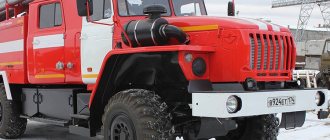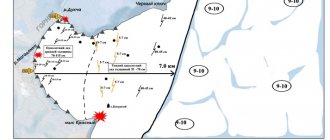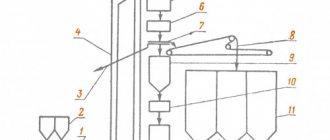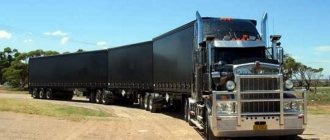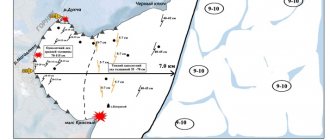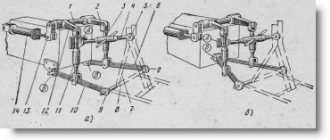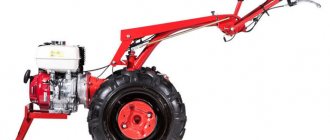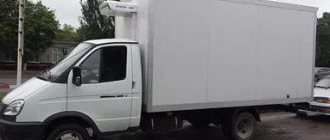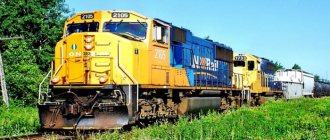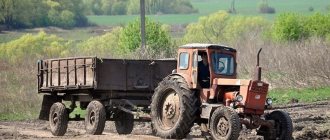Concept
In order to understand the location, calculation of boundaries and graphical/constructive identification of dangerous zones, you should first become familiar with the terminology. A danger zone is an area of the workspace where there is a high risk of harm to the health and life of workers.
They are available at any production area, regardless of its specifics. The nature of the work only affects the size and type of hazardous areas. Therefore, when organizing work, pay close attention to potentially dangerous areas and take measures to ensure safety in this area.
What colors are used for signal fences?
Signal color refers to a color that attracts people's attention and indicates potential or immediate danger. The full list of signal colors used is established by GOST 12.4.026-2015. These include red and yellow, blue and green.
Each color has its own meaning, which can be found in table 1 of GOST 12.4.026-2015. For signal fences, yellow and red are used. A specific color is chosen depending on the degree of danger in a certain territory or area.
Typically the signal color of safety fences is yellow. But it indicates a possible danger, warns and warns a person. The contrast to yellow is black. The use of contrasting colors helps to draw a person’s attention and enhance their perception of the designated boundaries.
Application of red color
Red may be used for fencing hazardous areas It is intended for temporary barrier structures, including those limiting access to areas where entry is temporarily prohibited.
The color red indicates immediate danger, an emergency or a hazardous situation. White is chosen as a contrast color. The fence is painted entirely red or alternating red and white stripes are made, made at an angle of 45-60°. Their width is 20-300 mm, and the ratio of the width of red to white stripes is 1:1 or 1.5:1. Red and white stripes are used for temporarily dangerous areas: falling objects from a height, emergency work, etc.
The yellow color occurs in the same way. Only in the case of stripes, black is used as a contrasting color. Yellow-black stripes are often used to highlight the boundaries of a permanently dangerous zone, for example, protruding parts of buildings, edges of openings, etc.
Kinds
Since a danger zone is a place where special safety regulations apply, you need to understand its types. The classification is based on factors affecting the safety of workers. They come in two types:
- permanent;
- potential.
This classification of factors was developed and established by the Ministry of Health of the Russian Federation. In addition, there is a list of GOSTs regulating the size and working conditions in unsafe working areas. The employer is responsible for their failure to comply.
Other prerequisites
If any work is to be carried out in a hazardous area, the nature of which is not related to the planned ones, such an action must be accompanied by the issuance of a permit.
If the construction site is organized in such a way that on the side where the building being erected is located there are no rail fences for the crane, any of the doorways facing it must be tightly closed.
If the crane is equipped with a magnet or grab, its operating area must be marked with appropriate warning signs in accordance with GOST and fenced off with signal boundaries.
People are prohibited from staying where such a crane operates. Its technical maintenance by auxiliary personnel is allowed only during breaks between periods of work, when the magnet or grab takes a stable position on the ground.
All crane operators and support workers must be instructed in safety precautions when carrying out such work. The crane operator must not only know well the definition of the dangerous zone of the crane and be able to set its boundaries, but also understand the routes of movement of the magnet and grab.
Areas with constant influence of risk factors
Hazardous work areas must have barriers to attract the attention of employees. The established standards for marking dangerous spaces depend on its type.
Areas with constant influence of hazard factors are located:
- near non-insulated conductive parts of electrical installations;
- near unfenced drops with a height of more than 1.3 m;
- with a concentration of harmful substances, noise, vibration and other harmful factors in excess of established standards.
This list applies to the areas of construction and repair services, production of building materials, production of building structures, structures and products. It is specified in building codes and regulations. You can read more about the full text of the document in SNiP 12-03-2001.
Fencing methods
Crane danger zone
The fencing of the danger zone is regulated by paragraph five of Appendix G of document SNiP 12-03-2001. Cranes must be equipped with devices that forcibly limit the range of operation of lifting equipment. The swing speed of the boom should be limited to the lowest possible if the distance from the operating radius to the load-handling device is less than seven meters.
In hazardous areas, it is necessary to use safety and safety devices that will prevent materials from falling. A protective screen is installed around the perimeter of the work area. It must be equal to or greater than the possible lifting height of materials on the hook within the danger radius.
The emergence of a high-risk zone when equipment components fall is not taken into account. Responsibility for preventing the occurrence of dangerous sections of the fence lies with the developer of the design documentation.
Video on the topic: Video briefing on labor protection
Leave a request to find the best price
Fill out the form below and a manager will call you back and advise you on any questions and select the best price in Russia
Calculation and determination of the danger zone when operating a crane Link to main publication
Potentially unsafe areas
Areas that pose a potential threat are influenced by temporary factors. Therefore, more lenient requirements for installing fencing apply to them. Potential risk areas include:
- space near buildings and structures being erected (under construction);
- areas on the floors of buildings and structures in one occupation, over which construction and installation work is carried out;
- areas for vehicles and other movable equipment;
- areas over which cargo is moved using cranes.
This list also applies to the construction industry. In places with permanent and potentially dangerous production factors, temporary and permanent residence zones for the organization’s employees cannot be located.
How to calculate?
Carrying out work when using lifting structures requires compliance with the rules to prevent falling loads while they are moving around the site. Lifting structures in this hazard group include cranes, cranes, and pipe-laying equipment.
The limits of dangerous zones during crane operation are set from the axis of the load-handling device. For calculation use the formula:
P = Gp + Mg/2 + X , where:
Scheme of assignment and calculation of tower crane zones
P – radius of action of a possible danger zone;
Гп – horizontal projection of the minimum parameters of the cargo when transporting it by lift;
Mg – maximum dimensional parameters of the transported cargo;
X – the shortest distance of the cargo departure.
The last parameter is determined by the height from which materials can fall. The correspondence is as follows:
| N, um, no more | 10 | 20 | 70 | 120 | 200 | 300 | 450 |
| Hm | 4 | 7 | 10 | 15 | 20 | 25 | 30 |
Thus, the distance of materials from the hook will be equal to seven meters if the distance from the hook to the floor is more than seven meters.
Calculation of the danger zone when operating a load-lifting crane
Since the rotation of the load-lifting crane occurs in a circle, the radius of the danger zone is taken as the desired value in the calculations. Signal barriers will be installed along it to prevent workers from being present during construction work.
For calculations you need to know three values:
- boom turning radius (Rc);
- total length of the structure (k);
- departure radius (ΔR).
The radius of rotation of the boom depends on the technical characteristics of the load-lifting crane, the total length of the structure depends on the object being built. To find the departure radius, it is enough to use tables with standard indicators.
The formula for calculating the danger zone is as follows:
Rо= Rс+0.5k + ΔR.
Based on the data obtained, it is possible to determine the exact circumference of the danger zone, taking the installation location of the crane as its center. This area must be highlighted with signal barriers that comply with GOST 12.4.059.-89.
Calculation by formula
For clarity, we present the formula. Calculation of the dangerous zone of crane operation, according to it, looks like this:
Rcr (o.z.) = P (max.) st. + 0.5 * P (min.) gr. + P (exc.) + P (max.) gr.,
where: Rcr (o.z.) - calculated radius of the dangerous zone of the crane;
R (max.) art. – the maximum reach of its arrow in meters;
0.5 R (min.) gr. – half the distance from the minimum cargo dimensions in meters;
P (exc.) – the minimum distance at which the transported cargo is capable of flying off, (in meters);
P (max.) gr. – the maximum of its dimensions in meters.
Danger zone identification
In order for workers to pay attention and avoid potentially dangerous space, it must be allocated in accordance with current GOSTs. As already mentioned, the nature of the markings depends on the factors that create hazardous conditions in the workplace.
Areas with constant influence of risk factors are highlighted by safety barriers. They must be installed along the entire perimeter of the enclosed space.
As for areas with potentially active factors, a dangerous zone can be identified in two ways: signal barriers or signs. A warning sign is a rectangular or square white sign with the words “Danger Area” written in red. But both signs and fences must comply with the established GOST. Fencing of dangerous areas is installed only after accurate calculation of the boundaries of the unsafe area.
I class location
This location contains flammable gases, vapors, or liquids that create a fire or explosion hazard. Class I hazardous substance classification practices of NFPA 497 (Ref. 2) provide for location.
Division 1
At this location, under normal operating conditions, there are flammable concentrations of flammable gases, vapors generated in a flammable liquid, or vapors generated in a flammable liquid.
Division 2
Flammable concentrations of flammable gases, flammable liquid vapors, or flammable liquid vapors exist at this location under abnormal operating conditions.
Group designation
There are four groups based on their physical properties −
- Group A - Acetylene
- Group B - Hydrogen
- Group C - Carbon Monoxide
- Group D - Gasoline
Marking in warehouses
As mentioned earlier, a danger zone is a space where there is a real threat to the health and life of workers. Such areas exist at any production enterprise, regardless of its field of activity. Therefore, they must be protected not only at construction sites.
Warehouses are also places where workers can often be injured. Most often this is due to the instability of boxes, containers, and packages stored in specially designated areas. Of course, with proper loading and storage, the risk of injury in the warehouse is low. However, due to the carelessness or inattention of employees and people responsible for observing safety rules, workers may suffer irreparable harm to their health. Therefore, hazardous production zones in warehouses are marked with appropriate markings.
What determines the safety of a crane?
A lot here is decided by the correct slinging of loads and the termination of the rope. It is attached to the metal parts of the tap using various types of hinges, couplings, knots, and wedge clamps. The loops at its ends are made by braiding, preventing flattening and chafing.
Splicing tower crane ropes is strictly prohibited. With its help, the load is attached to the lifting mechanism thanks to special devices in the form of blocks, drums, pulleys.
With the help of blocks, the load is lifted and lowered; the chain hoist is a system of interconnected movable and fixed blocks. Drums in lifting mechanisms look like hollow cylinders with helical grooves on the surface to facilitate rope laying and reduce its wear.
How are hazardous areas marked in warehouses?
Special markings are designed to focus workers' attention on potentially unsafe areas. Its application should only be carried out by repair or construction organizations. Applying markings yourself is not recommended.
Signal markings can be presented as:
- marking lines;
- floor signs “Danger zone”;
- arrows and other additional signal elements.
When applying special markings, repair and construction companies use brushes, paints with a special composition, stencils of letters, signs and other elements. The warehouse owner has the right to independently decide on the labeling method.
Marking methods:
- self-leveling floors that differ in color from the main work area;
- installation of color markings;
- applying signal markings.
As a rule, 4 colors are used for marking: red, yellow, green and blue. Identification of potentially unsafe areas is a mandatory requirement specified in the safety regulations. Therefore, the owner of the warehouse is responsible for the absence or application of markings that do not correspond to the boundaries of the danger zone.
The marking process. Benefits of labeling
If the warehouse owner is a private individual, it is important that the entrepreneur follows the full technological process for designing and marking. If the production facility has a separate labor protection service, then this process falls under its direct responsibilities. It includes several steps:
- Determining the location and type of potential threat.
- Coordination of the project with authorized organizations.
- Installation of markings in accordance with current standards and GOSTs.
To accurately determine the location and type of potential danger, a company can turn to the services of professionals who will conduct a thorough audit of the premises, correctly assessing all possible risks. Without this, you cannot begin work in a dangerous area, otherwise if a warehouse worker is injured, its owner will not only suffer huge losses, but also risk being left without a license.
Advantages of marking:
- designation of all potentially hazardous areas;
- the ability to apply markings to highlight passages;
- safe organization of cargo movement within the warehouse;
- protection against collisions with motor vehicles.
Markings can be applied not only to indicate dangerous zones, but also to graphically highlight workplaces, pedestrian and vehicle paths, floor cargo storage cells and other things. A well-designed floor plan significantly reduces the risk of any traumatic situation occurring at work.
Determination of fire and explosion hazardous areas: recommendations
Alexey SKRIPKO
The trend of constant updating and increasing the range of electrical equipment of domestic and imported production, expanding the scope of its use, increases the need for the correct identification of fire and explosion hazardous areas and the subsequent selection of electrical equipment that can ensure the safety of technological processes.
Help in the fields:
The safe operation of electrical equipment involved in the technological processes of enterprises must be ensured by the development of fire safety measures at the stage of design and operation of buildings and installations. Despite the introduction of the requirements of TKP 339-2011 “Electrical installations for voltages up to 750 kV. Overhead power lines and conductors, distribution devices and transformer substations, electric power and battery installations, electrical installations of residential and public buildings,” the definition of fire and explosion hazardous areas is carried out according to the Rules for the Construction of Electrical Installations (PUE).
The degree of explosion hazard and fire hazard of the indoor environment is regulated by chapters 7.3 “Electrical installations in explosive areas” and 7.4 “Electrical installations in fire hazardous areas” of the PUE.
A fire hazardous zone is a space indoors and outdoors, within which flammable (combustible) substances are constantly or periodically circulating, and in which they may be present during normal technological processes or disruptions.
There are four classes of fire hazardous zones, according to which electrical installations are selected and placed depending on the classification of combustible materials (liquids, dusts and fibers) circulating in the technological process:
1. Class P-I zones
— areas located in rooms where flammable liquids with a flash point above 61 ° C are handled;
2. Class P-II zones
— zones located in rooms where flammable dust or fibers with a lower flammable concentration limit of more than 65 g/m3 to air volume are emitted;
3. Class P-IIa zones
- areas located in rooms where solid flammable substances are handled;
4. Class P-III zones
- areas located outside areas where flammable liquids with a flash point above 61 ° C or solid flammable substances are handled.
Zones indoors or outside up to 5 m horizontally and vertically from the apparatus in which flammable substances are located, but the technological process is carried out using open fire, hot parts that have surfaces heated to the self-ignition temperature of flammable vapors, dust or fibers, In terms of their electrical equipment, they do not belong to fire hazardous areas! The class of the area outside the specified 5-meter zone should be determined depending on the technological processes used in this environment.
Areas indoors and outdoors where solid and gaseous flammable substances are burned as fuel or disposed of by combustion are also not classified as fire hazardous areas in terms of their electrical equipment!
When individual fire-hazardous equipment is placed indoors or outdoors, when special measures against the spread of fire are not provided, the area within 3 m horizontally and vertically from this equipment is a fire hazard.
There are six classes of explosive zones, according to which electrical installations are selected and placed depending on the types of explosive mixtures circulating in the production process:
1. Class B-I zones
- zones located in rooms where flammable gases (GG) and vapors of flammable liquids are emitted in such quantities and with such properties that they can form explosive mixtures with air under normal operating conditions, for example, when loading or unloading technological devices, storage or transfusion flammable liquids located in open containers, etc.;
2. Class B-Ia zones
- zones located in rooms where, during normal operation, explosive mixtures of gases (regardless of the lower concentration limit of ignition) or flammable liquid vapors with air are not formed, but are possible only as a result of accidents or malfunctions;
3. Class B-Ib zones
- zones located in premises where, during normal operation, explosive mixtures of gases or flammable liquid vapors with air are not formed, but are possible only as a result of accidents or malfunctions and which are distinguished by one of the following features:
3.1.
GG in these areas have a high lower concentration limit of ignition (15% or more) and a pungent odor at maximum permissible concentrations (for example, machine rooms of ammonia compressor and refrigeration absorption units);
3.2.
premises of production facilities associated with the circulation of hydrogen gas, in which, according to the conditions of the technological process, the formation of an explosive mixture in a volume exceeding 5% of the free volume of the room is excluded, have an explosive zone only in the upper part of the room. The explosive zone is conventionally taken from 0.75 of the total height of the room, counting from the floor level, but not above the crane runway, if any (for example, water electrolysis rooms, charging stations for traction and starter batteries).
Class B-Ib also includes areas of laboratory and other premises in which gas and flammable liquids are present in quantities insufficient to create an explosive mixture in a volume exceeding 5% of the free volume of the room, and in which work with gas and flammable liquids is carried out without the use of an open flame . These areas are not considered explosive if work with gas and flammable liquids is carried out in fume hoods or under exhaust hoods.
4. Class B-Ig zones
- spaces near external installations: technological ones containing flammable liquids or flammable liquids (with the exception of external ammonia compressor units), above-ground and underground tanks with flammable liquids or flammable liquids (gas holders), racks for draining and loading flammable liquids, open oil traps, settling ponds with a floating oil film and so on.;
5. Class B-II zones
- zones located in rooms where flammable dusts or fibers are released into suspension in such quantities and with such properties that they are capable of forming explosive mixtures with air under normal operating conditions (for example, when loading and unloading technological equipment);
6. Class B-IIa zones
- zones located in premises where the hazardous conditions specified in zone B-II do not occur during normal operation, but are possible only as a result of accidents or malfunctions.
Zones in premises and areas of outdoor installations within up to 5 m horizontally and vertically from the apparatus in which explosive mixtures are present or may occur, but the technological process is carried out using open fire, hot parts, or the technological apparatus has surfaces heated to the auto-ignition temperature GG , flammable liquid vapors, flammable dusts or fibers are not classified as explosive in terms of their electrical equipment. The classification of indoor environments or outdoor environments outside the specified 5-meter zone should be determined depending on the technological processes used in this environment.
Indoor areas and outdoor areas in which solid, liquid and gaseous flammable substances are burned as fuel or disposed of by combustion are not considered explosive in terms of their electrical equipment.
Example No. 1.
Within a warehouse with length L = 10 m, width S = 8 m, height h = 4 m, there are 10 liters of ethyl alcohol (0.5 liters in glass containers). When calculated, the volume of the explosive mixture created by ethyl alcohol during bottling is 2.75 m3.
Sidebar in the margin:
Ethyl alcohol is a flammable colorless liquid, Flash point - 12 ° C; auto-ignition temperature - 445 °C; the lower concentration limit of flame propagation is 1.65%. Temperature limits for flame propagation: lower - 8 °C, upper - 40 °C.
Ethyl alcohol vapors with air form an explosive mixture. Since the technological process occurs only when the glass container is depressurized, therefore, an explosive mixture of ethyl alcohol vapor and air will form under normal conditions. Based on this, we conclude that an explosive zone of class B-Ia will form in the warehouse premises in accordance with clause 7.3.40 of the PUE.
When determining the size of the hazardous area, it is assumed that:
— the explosive zone in the room occupies its entire volume if the volume of the air pollution control exceeds 5% of the free volume of the room;
— an explosive zone in a room is considered to be within a range of up to 5 m vertically and horizontally from the process apparatus, if the volume of the explosive atmosphere is equal to or less than 5% of the free volume of the room.
To determine the size of the explosive zone, we find the free volume of the room:
— Vpom. = S • L • h = 10 • 8 • 4 = 320 m3;
— Vpom. free = Vpom. • 0.8 = 320 • 0.8 = 256 m3,
where Vpom. — volume of the room, m3.
We find the ratio of the volume of the explosive mixture to the free volume of the room:
VZOS/Vpom.free • 100% = (2.75/256) • 100% = 1.1%.
The volume of the explosive mixture is less than 5% of the free volume of the room, therefore, the explosive zone of class B-Ia occupies the volume of the warehouse within 5 m horizontally and vertically; 0.5 m horizontally and vertically from openings behind the external enclosing structures of the warehouse premises; class zone - B-Ig.
Electrical equipment located within the explosive zone must have a degree of enclosure protection corresponding to the explosive class of zone B-Ia. Outside the hazardous area, classes are determined depending on the technological processes used in this environment.
Example No. 2.
The production facility contains technological equipment that uses an explosive substance - solvent R-4. The internal dimensions of the room are as follows: length L = 30 m; width S = 15 m; height h =4 m. Maximum volume of explosive mixture VVZOS = 1600 m3. The volume of installed equipment Vrev = 20 m3. Technological equipment - open installation for the preparation of rubber glue.
Box right there in the margin
Solvent R-4 is a flammable liquid. Flash point - -7 °C; auto-ignition temperature - 550 °C; the lower concentration limit of flame propagation is 1.65%. Temperature limits for flame propagation: lower - 9 °C, upper - 19 °C.
Pairs of solvent R-4 with air form an explosive mixture. Since the technological process occurs by mixing the ingredients in an open container, therefore, an explosive mixture of R-4 solvent vapors with air will be formed under normal conditions. Based on this, we conclude that an explosive zone of class B-I will be formed in the workshop premises in accordance with clause 7.3.40 of the PUE.
When determining the size of the hazardous area, it is assumed that:
— the explosive zone in the room occupies its entire volume if the volume of the air pollution control exceeds 5% of the free volume of the room;
— an explosive zone in a room is considered to be within a range of up to 5 m vertically and horizontally from the process apparatus, if the volume of the explosive atmosphere is equal to or less than 5% of the free volume of the room.
To determine the size of the explosive zone, we find the free volume of the room:
— Vpom. = S • L • h = 30 • 15 • 4 = 1800 m3;
— Vroom free = Vroom – Vobor. = 1800 – 20 = 1780 m3,
where Vroom is the volume of the room, m3.
We find the ratio of the volume of the explosive mixture to the free volume of the room:
VZOS/Vpom.free • 100% = (1600/1780) • 100% = 89.9%.
The volume of the explosive mixture is more than 5% of the free volume of the room, therefore, the explosive zone of class B-I occupies the entire volume of the room. Electrical equipment located indoors must have a degree of enclosure protection corresponding to the explosive class of zone B-I. Within 5 m horizontally and vertically from the door opening, electrical equipment must have class zone B-Ia, and at a distance of 0.5 m horizontally and vertically from openings behind the external enclosing structures of the room - B-Ig.
Example No. 3.
A lathe is located within the production area. The machine uses 3 liters of industrial oil as a cutting fluid. Industrial oil is a flammable liquid with a flash point of 355 °C, therefore, in accordance with clause 7.4.10. PUE within 3 m horizontally and vertically from the machine, the production area belongs to the fire hazardous class of zone P-I.
Recommendations for determining the classes of fire and explosion hazardous areas and choosing electrical equipment
Sequence for selecting electrical equipment:
1.
The following positions are defined:
- what does the electrical installation refer to (is it located indoors or refers to an outdoor installation);
— what substances and materials are used (name, their properties, including categories, groups of explosive mixtures, temperature classes (Table 7.3.3, 7.3.5–7.3.7 PUE).
2.
Based on factual information (during the inspection of an electrical installation) or normatively, the class of the explosive zone and its dimensions according to the PUE are determined. The class of an explosive zone is determined based on the technological features of electrical equipment, as well as the worst case scenario of an accident (clauses 7.3.40–7.3.43, 7.3.45, 7.3.46 PUE);
3.
Based on calculated information or regulations, the parameters of the explosive zone at the locations of electrical equipment are determined (clauses 7.3.39, 7.3.45, 7.3.47, 7.3.49 PUE);
4.
A regulatory analysis is carried out of the compliance of the marking of explosion-proof electrical equipment with the class of an explosive zone (Table 7.3.10–7.3.12, clause 7.3.48, 7.3.50 PUE);
5.
Based on the provisions of paragraphs 1–4, a conclusion is drawn up on the possibility of safe use of electrical equipment in an explosive zone.
Taking into account the above points, a specification for explosion-proof electrical equipment used in explosive zones is also drawn up, namely, it is determined:
— type of explosion protection;
— explosion protection marking;
— explosive conditions of use (class of hazardous area, category and group of explosive mixture).
The availability of a certificate (copy of the certificate) on the explosion protection of the product (or a batch of similar products) is checked. The certificate must indicate the standard according to which the explosion-proof electrical equipment is manufactured; type of explosion protection; explosion protection marking and explosive environment for which the electrical equipment is designed. The certificate must be agreed upon with the national (foreign) testing organization.
In addition, if necessary, during the examination of electrical equipment, installation and operating instructions, assembly drawings of electrical equipment or its components indicating measures, means and parameters that ensure explosion protection may be requested.
